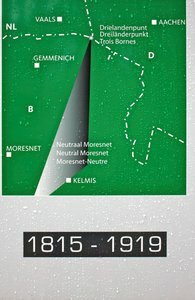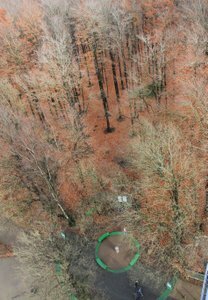The History of Amikejo
What is Amikejo, that mysterious sounding word? Amikejo isn‘t a legend, it is a once lived utopia. That part of european history would have almost forgotten, had a few important books and journalistic articles not been published in the past years.1
The neutral zone Amikejo existed from 1816 to 1919, named Neutral-Moresnet, as the smallest sovereign territory in Europe. At the end of Napoleonic Wars at the Congress of Vienna neither Prussia nor the Netherlands were willing to start a war about the disputed territory of 3.5 square-kilometres with an important zinc mine. So it was released into neutral independence.
With the name Amikejo, meaning "Place of Friendship", it was declared to be an Esperanto Republic in 1907. Esperanto is an artificial language, published by Ludwik Lejzer Zamenhof in 1887, a neutral language for international understanding. 2
One century long Amikejo existed in peace beyond any national states, and in turn it kept these national states in peace.
The place Kelmis is located in Belgium, between Aachen, Maastricht and Liége (today a “Euregion”). The most important zinc ore that was mined and smelt in Moresnet, was sphalerite and calamine. At the German-Belgian border area the dialectal term “Kelmis” for calamine was widely used. That term is reflected also in the name of the place which is located in the region of Altenberg. However, the french name “Calamine” became official to describe calamine itself. Respectively, also the place “Kelmis” is named “La Calamine” in the French version. The surface mining can still be seen in some stone houses and zinc veneerings at “Kelmis” and in black slags below ground at the so called “Casino-Lake” that arose for cooling the glowing slags. The museum of local history Röhltal shows the history of mining, of the demarcation and the 28 boundary stones as well as political desire of independence with pictures of the citizens, their own stamps and hymn.
So Amikejo is discrepancy and penetration. It loves diversity more than uniformity, self-determination more than bureaucracy. It withstands discrepancy and enables penetration. It is a place that offers space, space to breath, to move, to create new ways and open new horizons. Amikejo is a symbol of a possible utopia that already existed in Europe and therefore it actually is less far away from an existing utopia than it might be assumed.
1 Neal Ascherson, "Das große und das kleine Glück Europas", in Le Monde diplomatique, Nr. 9776, 13. April 2012
2 Catherin Hug zur Ausstellung: "Europa, Die Zukunft der Geschichte", Kunsthaus Zürich, Verlag Neue Zürcher Zeitung, 2015
Bilder: Valeska Peschke, aus der 01-80 Diaserie "Auf der Suche nach Amikejo", 2012-2015
Vaalsberg A_04/Dreiländerpunkt A_26/Schild Neutral-Moresnet A_17/Zinkmine, Ausschnitt Ölgemälde A_54/ Zinkblende , Gröltal Museum A_55
Journalist Neal Ascherson über Amikejo
Copyright © All Rights Reserved Idea & Concept & Art by Valeska Peschke, Berlin 2017



